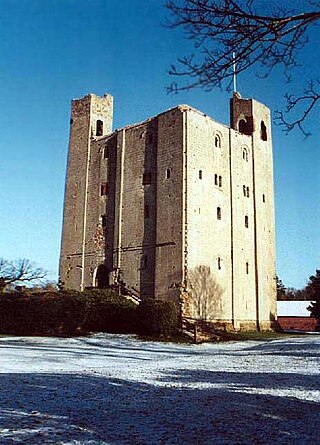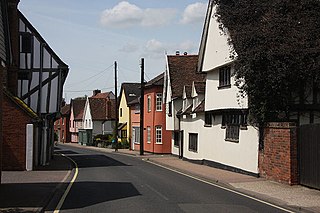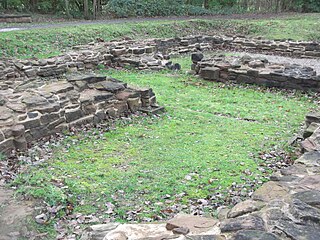Related Research Articles
William de Vere was Bishop of Hereford and an Augustinian canon.

Hedingham Castle, in the village of Castle Hedingham, Essex, is arguably the best preserved Norman keep in England. The castle fortifications and outbuildings were built around 1100, and the keep around 1140. However, the keep is the only major medieval structure that has survived, albeit less two turrets. It is a Grade I listed building and a scheduled monument. The keep is open to the public.

Castle Hedingham is a village in northern Essex, England, located four miles west of Halstead and 3 miles southeast of Great Yeldham in the Colne Valley on the ancient road from Colchester, Essex, to Cambridge.
Aubrey de Vere — also known as "Alberic[us] de Ver" and "Albericus regis camerarius" — was the second of that name in England after the Norman Conquest, being the eldest surviving son of Aubrey de Vere and his wife Beatrice.

Aldringham cum Thorpe is a civil parish in the East Suffolk district of Suffolk, England. Located south of the town of Leiston, the parish includes the villages of Aldringham and Thorpeness, which is on the coast, between Sizewell (north) and Aldeburgh (south). In 2007 it had an estimated population of 700, rising to 759 at the 2011 Census.

Aubrey de Vere, 2nd Earl of Oxford, hereditary Master Chamberlain of England, served in military campaigns under King Richard and King John. He was succeeded in the earldom by his brother, Robert de Vere, 3rd Earl of Oxford.

Bures is a village in eastern England that straddles the Essex/Suffolk border, made up of two civil parishes: Bures Hamlet in Essex and Bures St. Mary in Suffolk.

Aubrey de Vere, 1st Earl of Oxford was an English noble involved in the succession conflict between King Stephen and Empress Matilda in the mid-twelfth century.

Earls Colne is a village in Essex, England named after the River Colne, on which it stands, and the Earls of Oxford who held the manor of Earls Colne from before 1086 to 1703.
Agnes of Essex, Countess of Oxford was the daughter of a royal constable Henry of Essex and his first Cecily. At the age of three she was betrothed to Geoffrey de Vere, brother of the first Earl of Oxford, and turned over to be raised by the Veres soon thereafter. She remained in the household of the earl of Oxford about three years, then moved to Geoffrey's care. In her eleventh year Agnes rejected the match with Geoffrey and by early 1163 was married to his eldest brother Aubrey de Vere III, 1st Earl of Oxford, as his third wife.
Hedingham Priory was a Benedictine nunnery in Castle Hedingham, Essex, founded in or before 1190 by Aubrey de Vere, 1st Earl of Oxford, perhaps in partnership with his third wife, Agnes of Essex. It was dedicated to the Virgin Mary, St. James, and the Holy Cross.

Hugh de Vere, 4th Earl of Oxford was the only son and heir of Robert de Vere, 3rd Earl of Oxford and Isabel de Bolebec, daughter and eventually sole heiress of Hugh de Bolebec.

Hatfield Broad Oak Priory, or Hatfield Regis Priory, is a former Benedictine priory in Hatfield Broad Oak, Essex, England. Founded by 1139, it was dissolved in 1536 as part of Henry VIII's dissolution of the monasteries.
Aubrey (Albericus) de Vere was a tenant-in-chief in England of William the Conqueror in 1086, as well as a tenant of Geoffrey de Montbray, bishop of Coutances and of Count Alan, lord of Richmond. A much later source named his father as Alphonsus.
John de Vere, 14th Earl of Oxford was an English peer and landowner.
Maud de Badlesmere, Countess of Oxford was an English noblewoman, and the wife of John de Vere, 7th Earl of Oxford. She, along with her three sisters, was a co-heiress of her only brother Giles de Badlesmere, 2nd Baron Badlesmere, who had no male issue.

Horton-cum-Studley is a village and civil parish in Oxfordshire about 6+1⁄2 miles (10.5 km) northeast of the centre of Oxford and bordering Otmoor, and is one of the "Seven Towns" of Otmoor. The 2011 Census recorded the parish's population as 455. A majority of residents in the village work in the Healthcare and Educational Sectors.

Sandwell Priory was a small medieval Benedictine monastery, near West Bromwich, then part of Staffordshire, England. It was founded in the late 12th century by a local landowner and was only modestly endowed. It had a fairly turbulent history and suffered considerably from mismanagement. It was dissolved in 1525 at the behest of Cardinal Wolsey – more than a decade before the main Dissolution of the Monasteries under Henry VIII.

The House of de Vere were an English aristocratic family who derived their surname from Ver, in Lower Normandy, France. The family's Norman founder in England, Aubrey (Albericus) de Vere, appears in Domesday Book (1086) as the holder of a large fief in Essex, Suffolk, Cambridgeshire, and Huntingdonshire. His son and heir Aubrey II became Lord Great Chamberlain of England, an hereditary office, in 1133. His grandson Aubrey III became Earl of Oxford in the reign of King Stephen, but while his earldom had been granted by the Empress Matilda and eventually recognised by Stephen, it was not until January 1156 that it was formally recognised by Henry II and he began to receive the third penny of justice from Oxfordshire.
References
- ↑ "Houses of Benedictine monks: Priory of Earl's Colne". Institute of Historical Research. Retrieved 3 September 2022.
- ↑ "Earls Colne in Earliest Times". Earls Colne Heritage Museum. Retrieved 3 September 2022.
- ↑ "Houses of Benedictine monks: Priory of Earl's Colne". Institute of Historical Research. Retrieved 3 September 2022.
- ↑ "Colne Priory, Earls Colne Near Colchester, Essex - Archaeological Evaluation and assessment of Results". Archaeology Data Service. Retrieved 3 September 2022.
- ↑ "Colne Priory". Historic England. Retrieved 3 September 2022.
- ↑ "Earls Colne in Earliest Times". Earls Colne Heritage Museum. Retrieved 3 September 2022.
- ↑ "Colne Priory, Earls Colne Priory". Wessex Archaeology. Retrieved 3 September 2022.
- ↑ "Earls Colne in Earliest Times". Earls Colne Heritage Museum. Retrieved 3 September 2022.
- ↑ "Earls Colne: Priory buildings". Institute of Historical Research. Retrieved 3 September 2022.
- ↑ The National Archives, C 66/668, mm. 26-7.
- ↑ "Earls Colne: Priory buildings". Institute of Historical Research. Retrieved 3 September 2022.
- ↑ "Richard de Vere, 11th Earl of Oxford". Bowyers. Retrieved 3 September 2022.
- ↑ "ST. STEPHEN'S CHAPEL, BURES". Colne-Stour. Retrieved 3 September 2022.
- ↑ "Colne Priory". Historic England. Retrieved 3 September 2022.
- ↑ "Colne Priory, Earls Colne Priory" (PDF). Wessex Archaeology. Retrieved 3 September 2022.